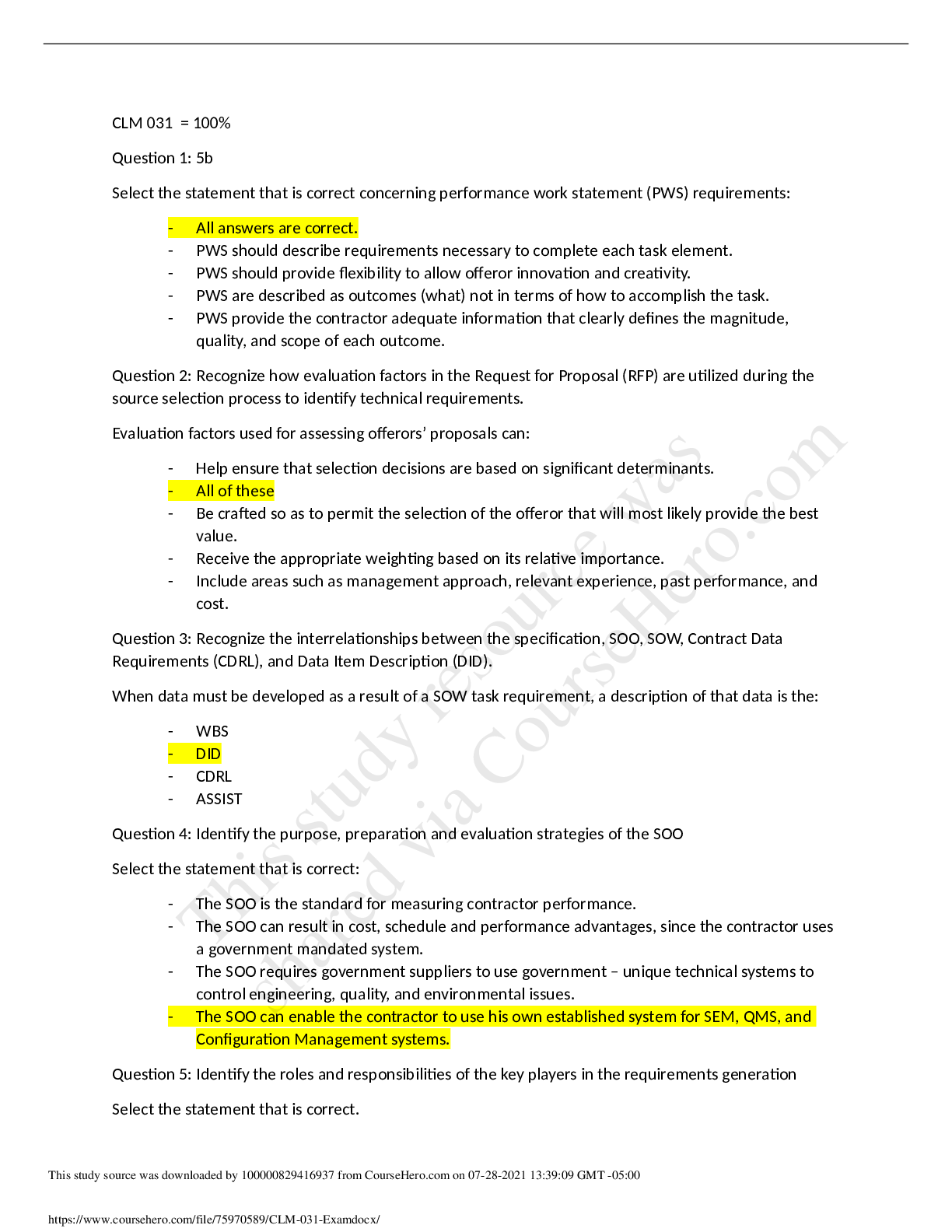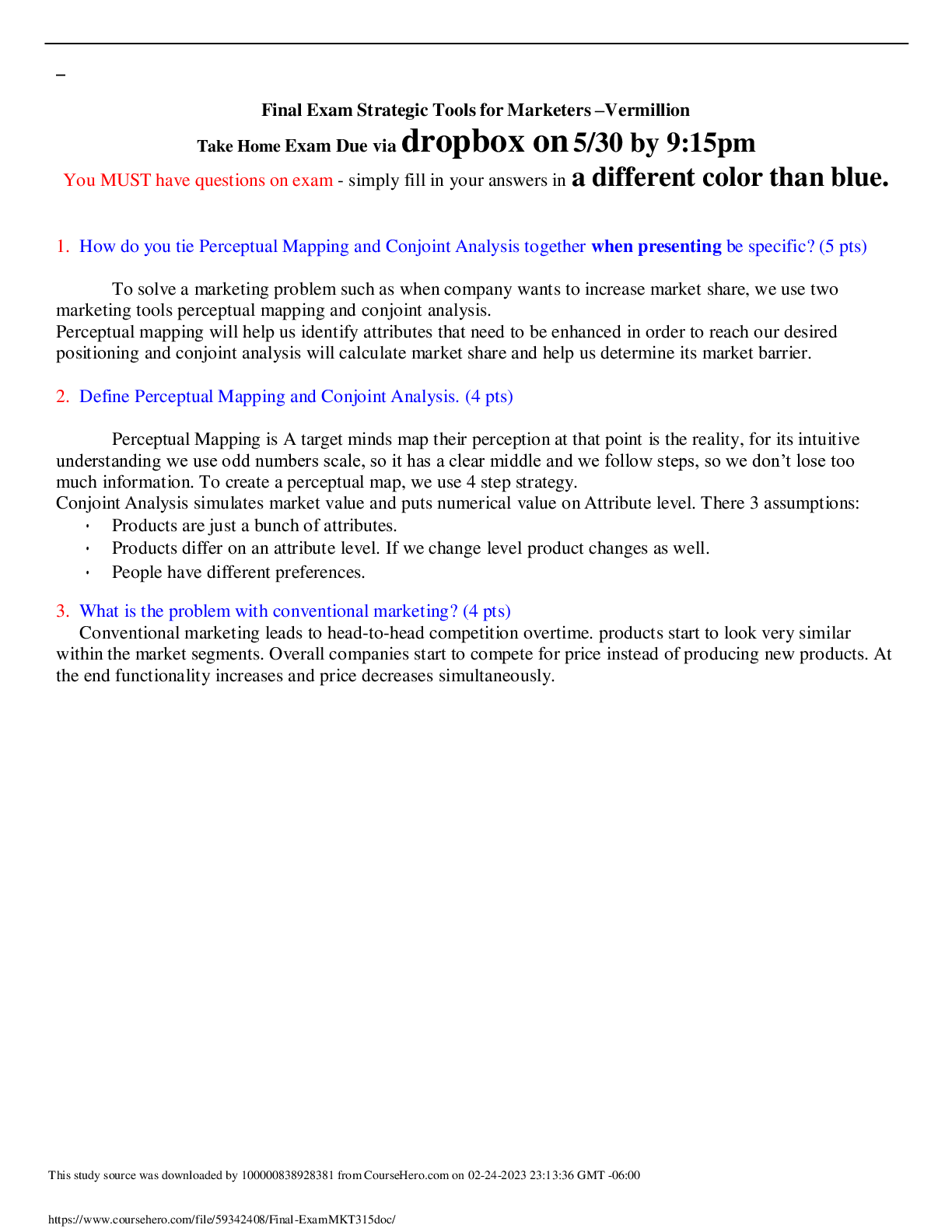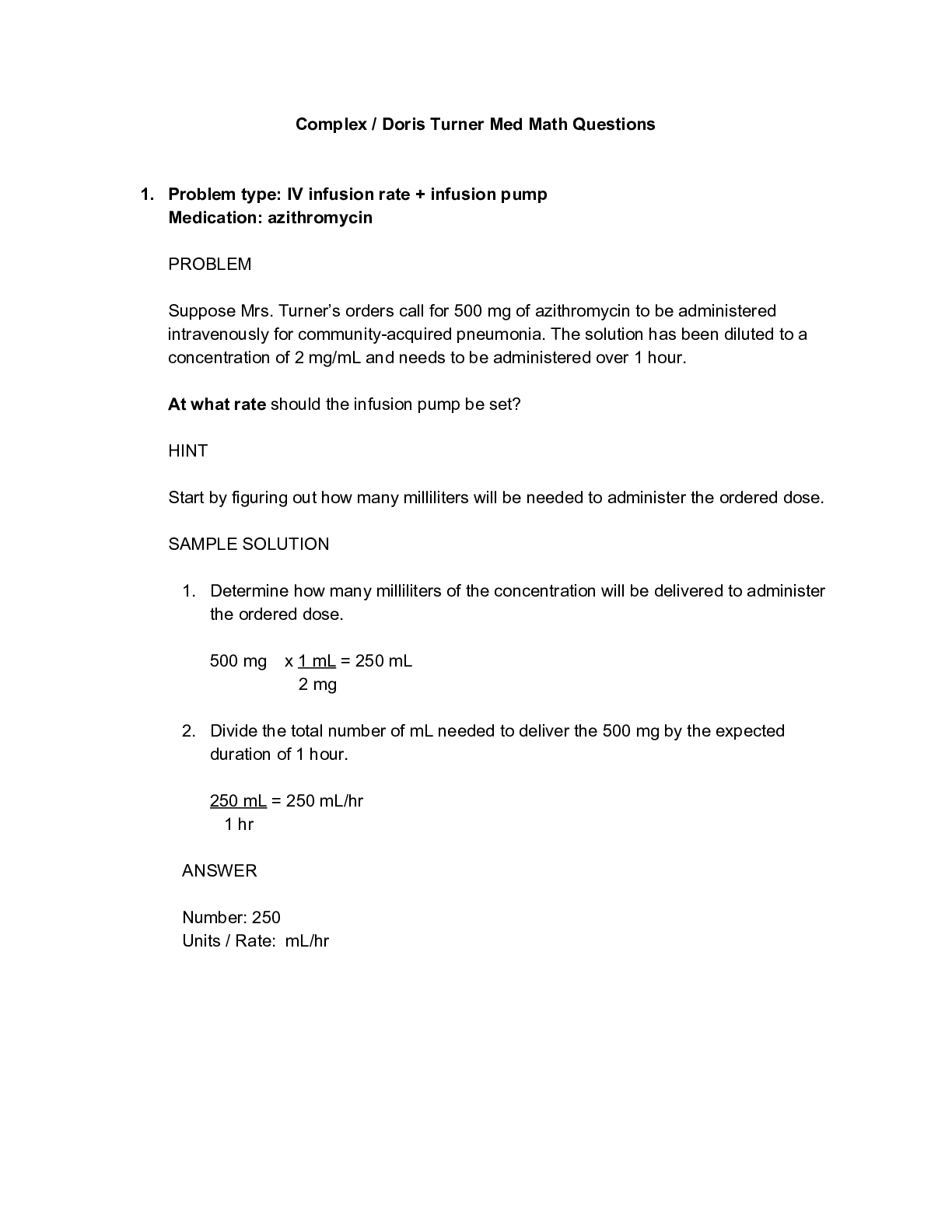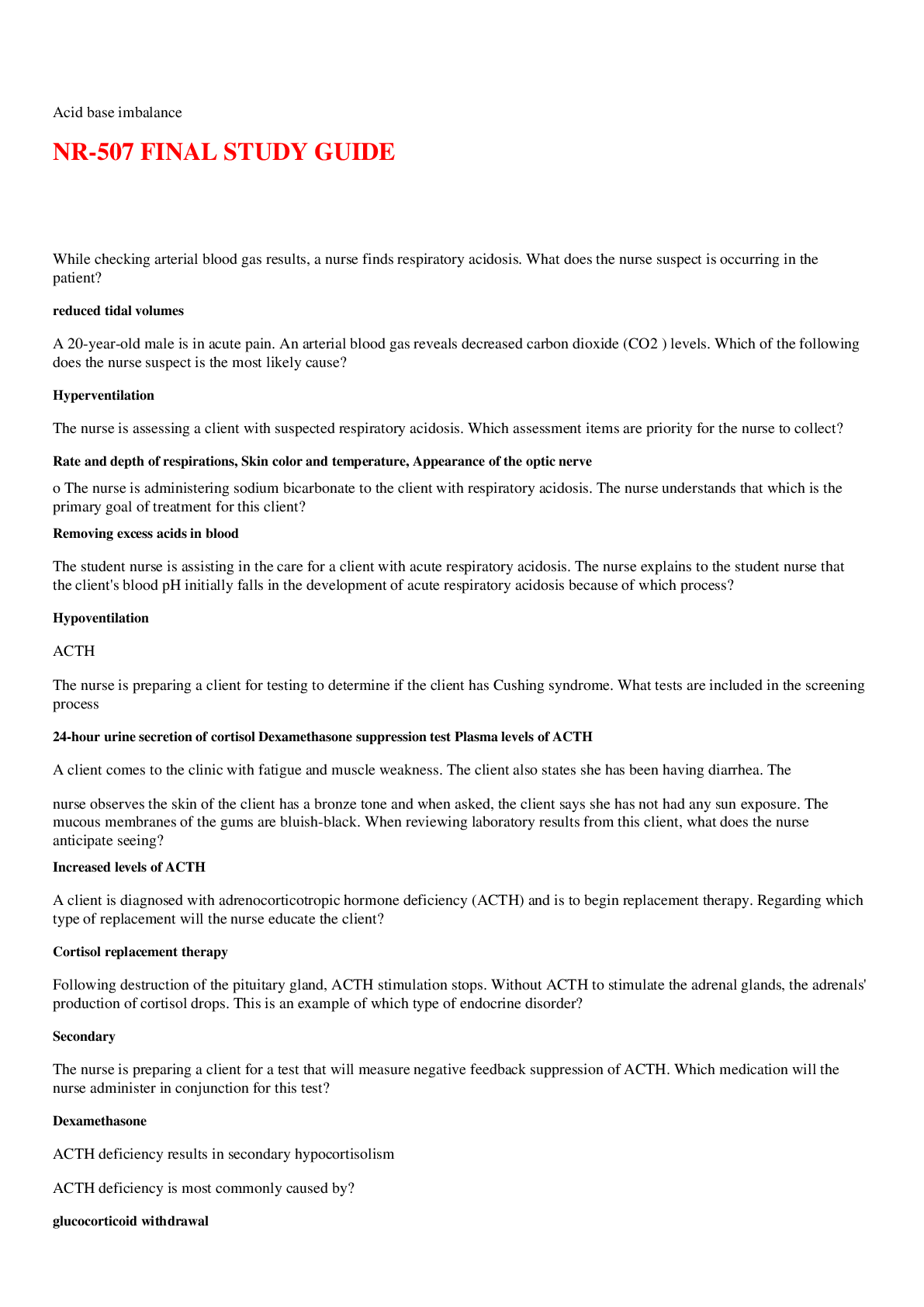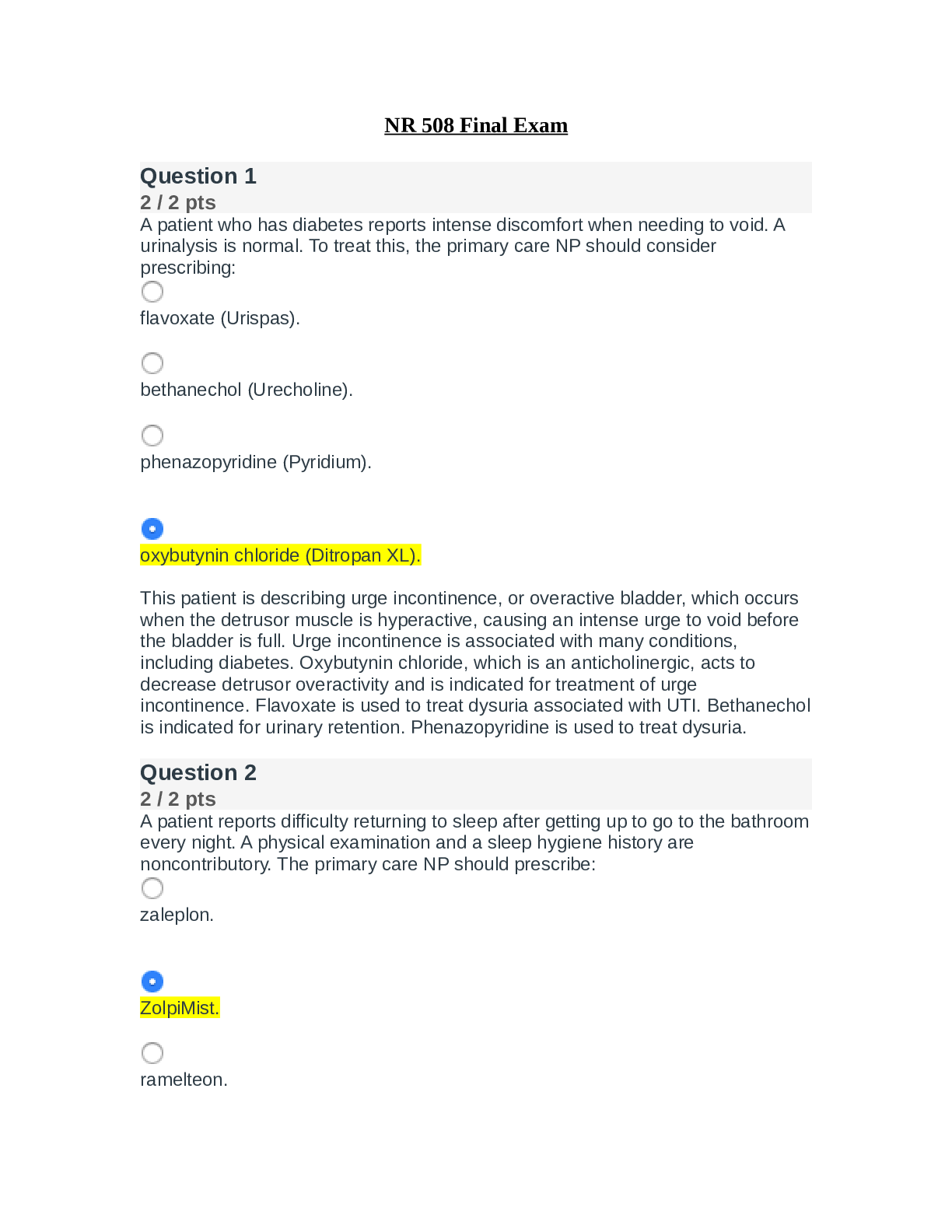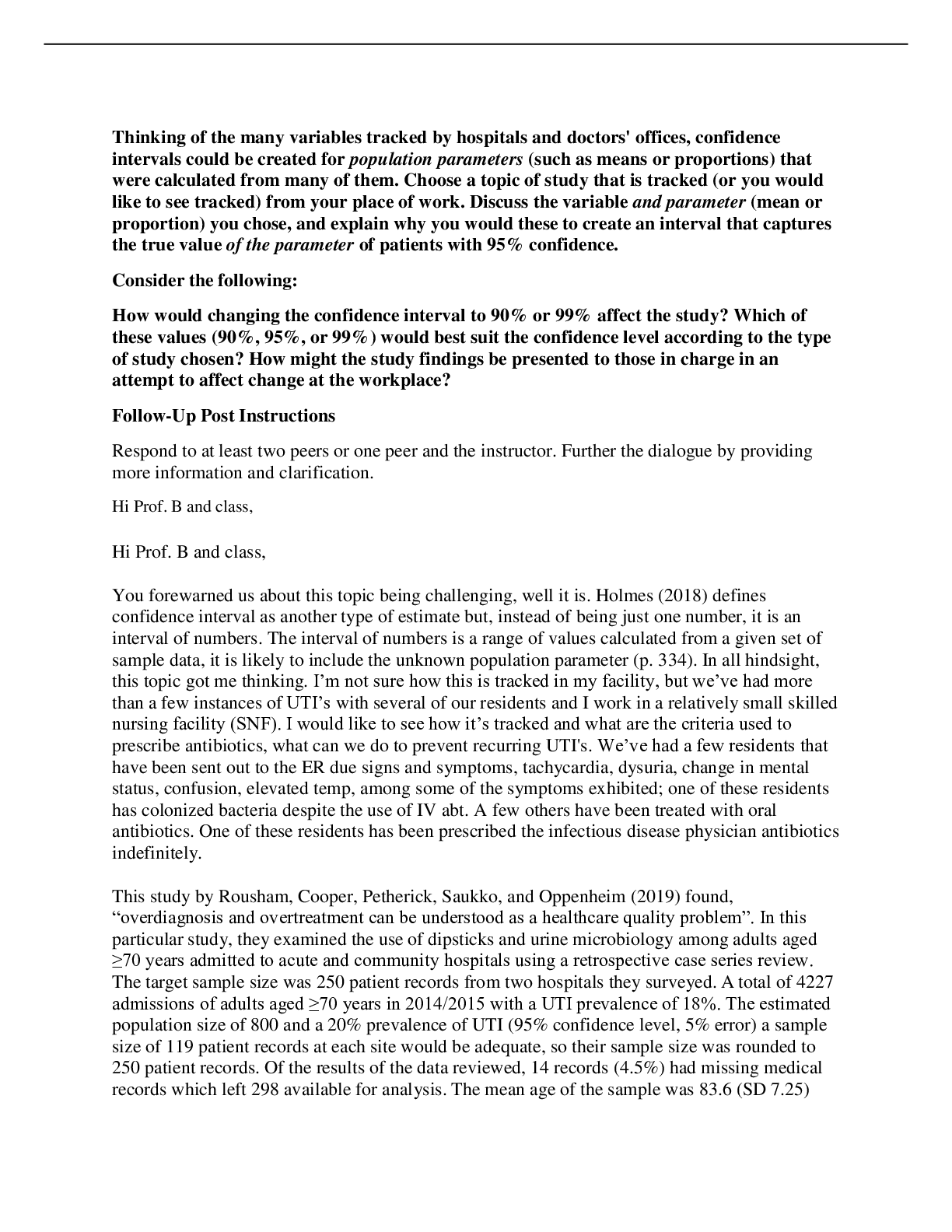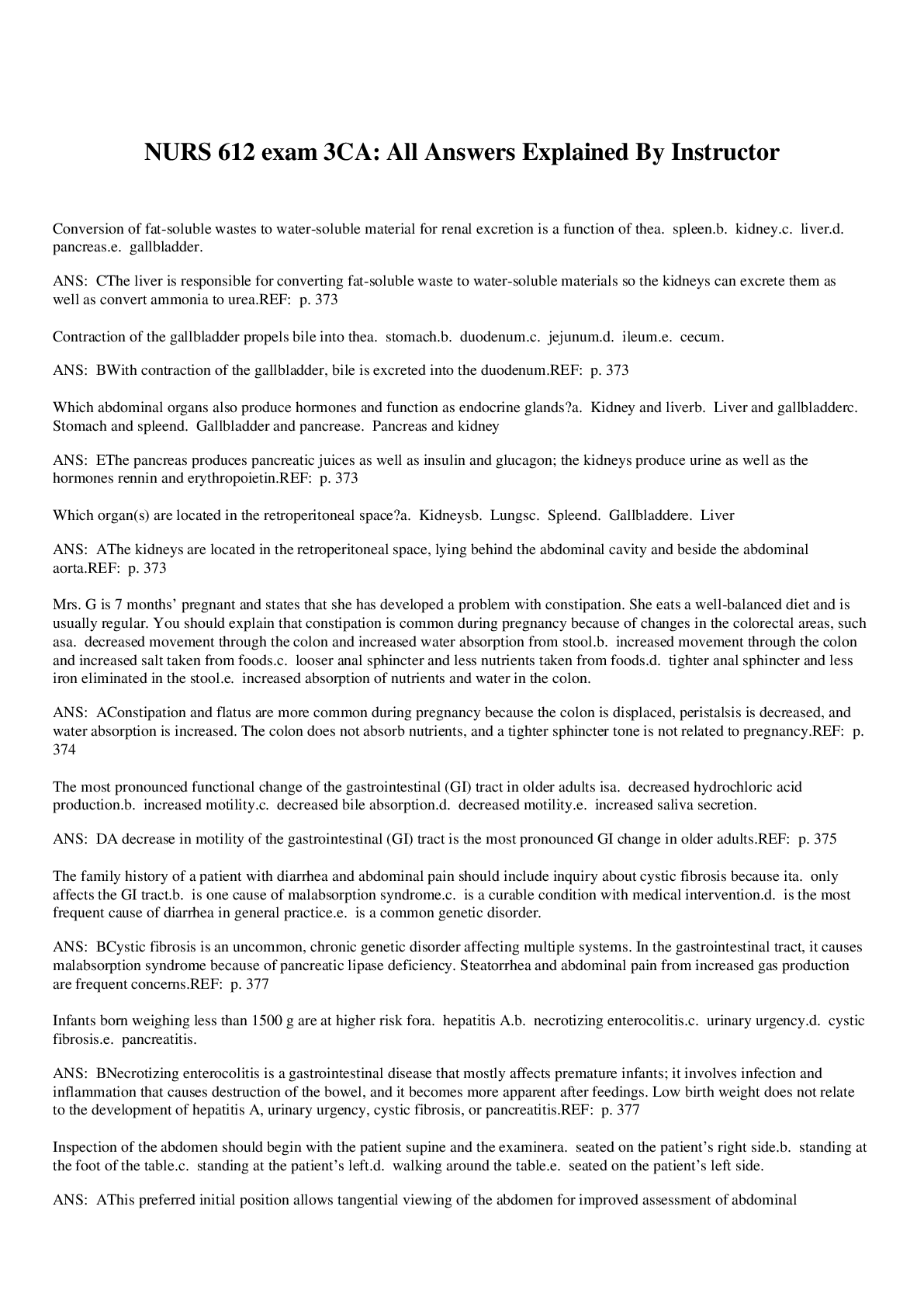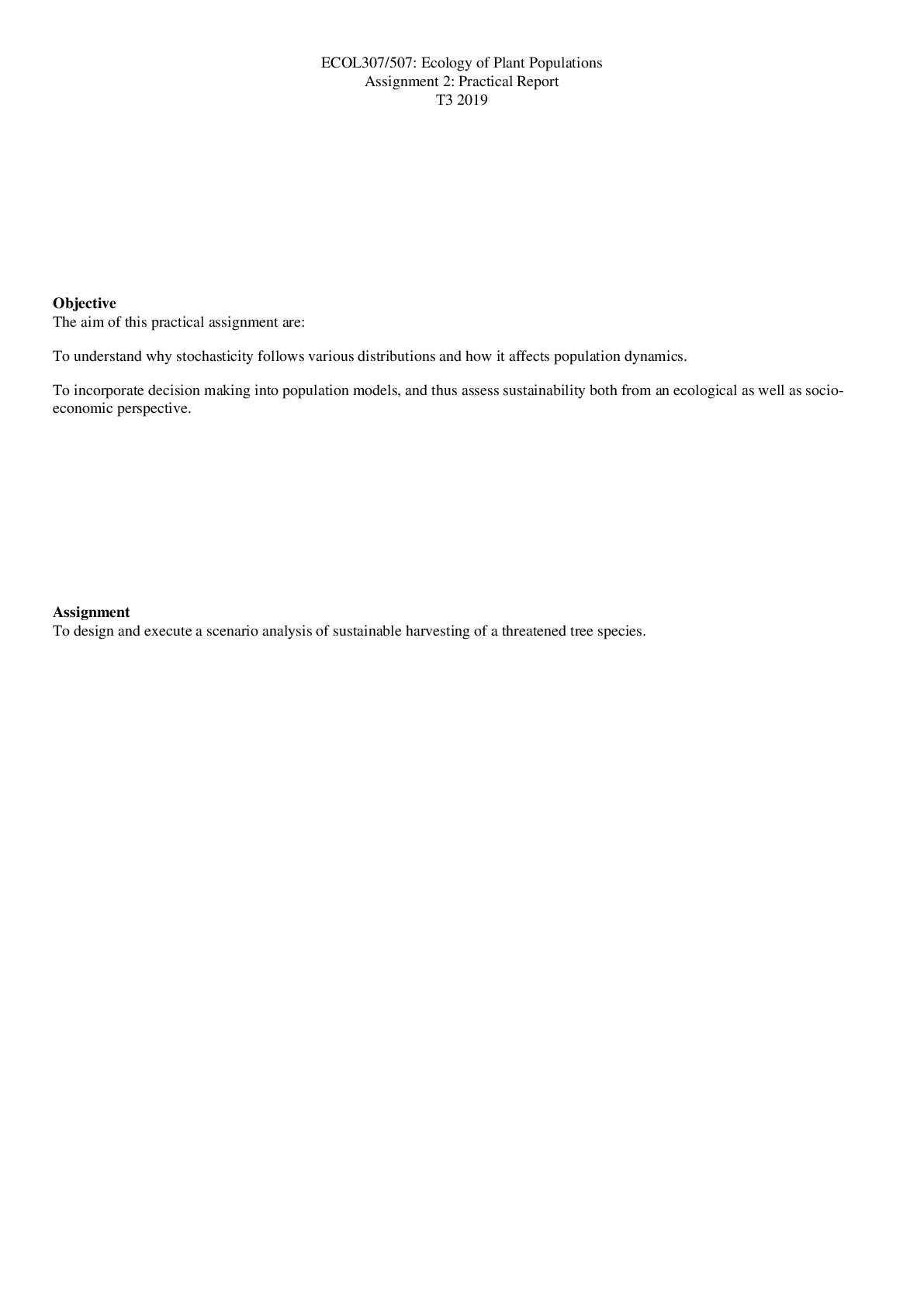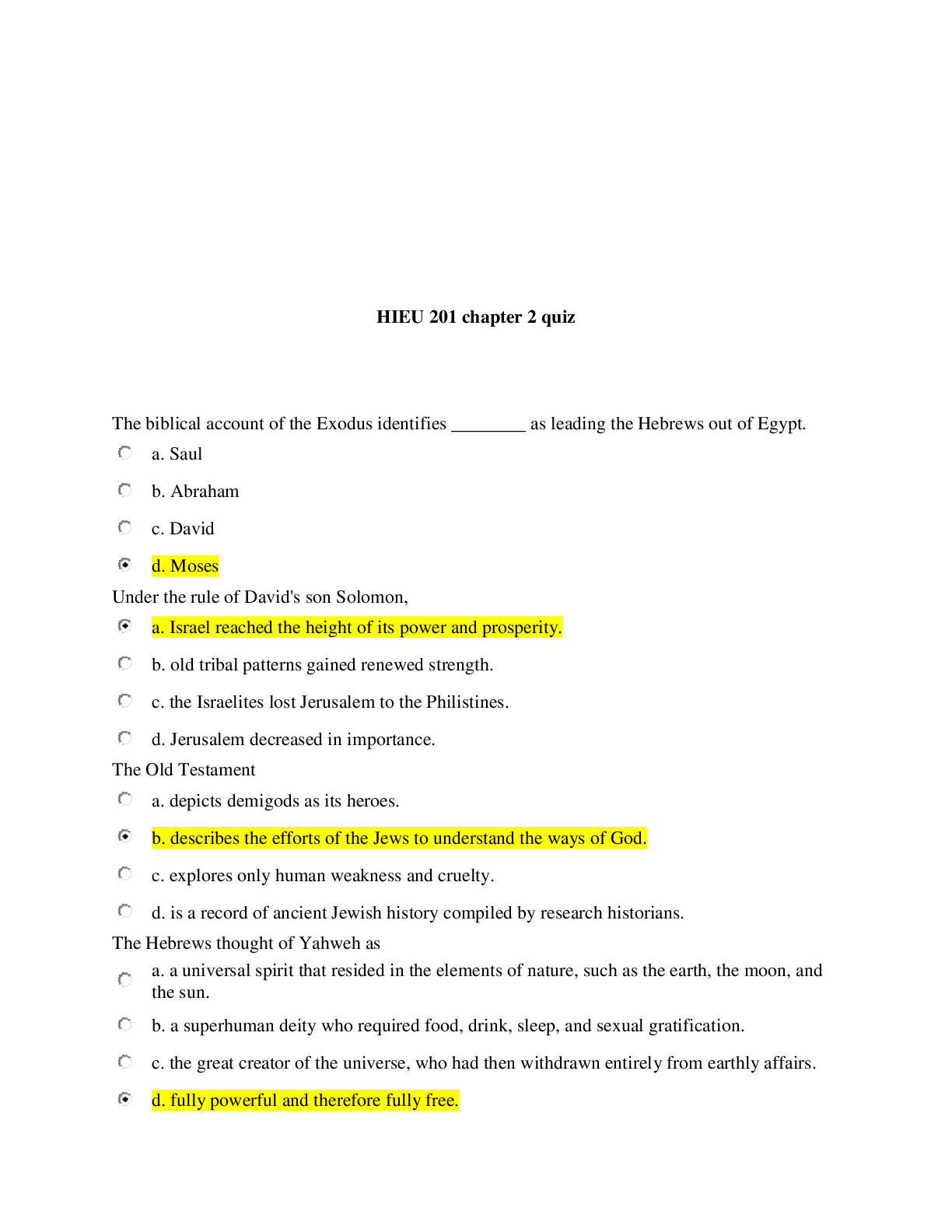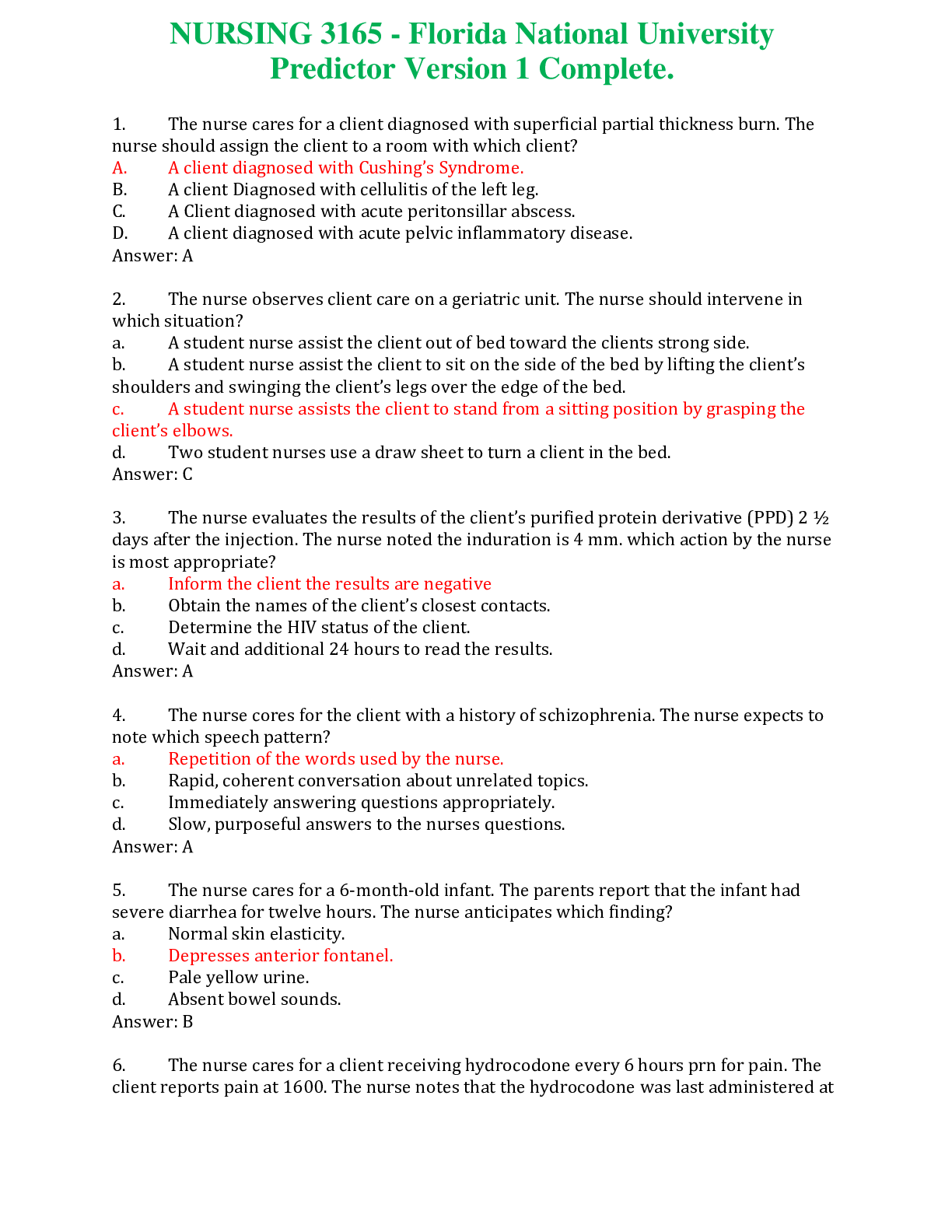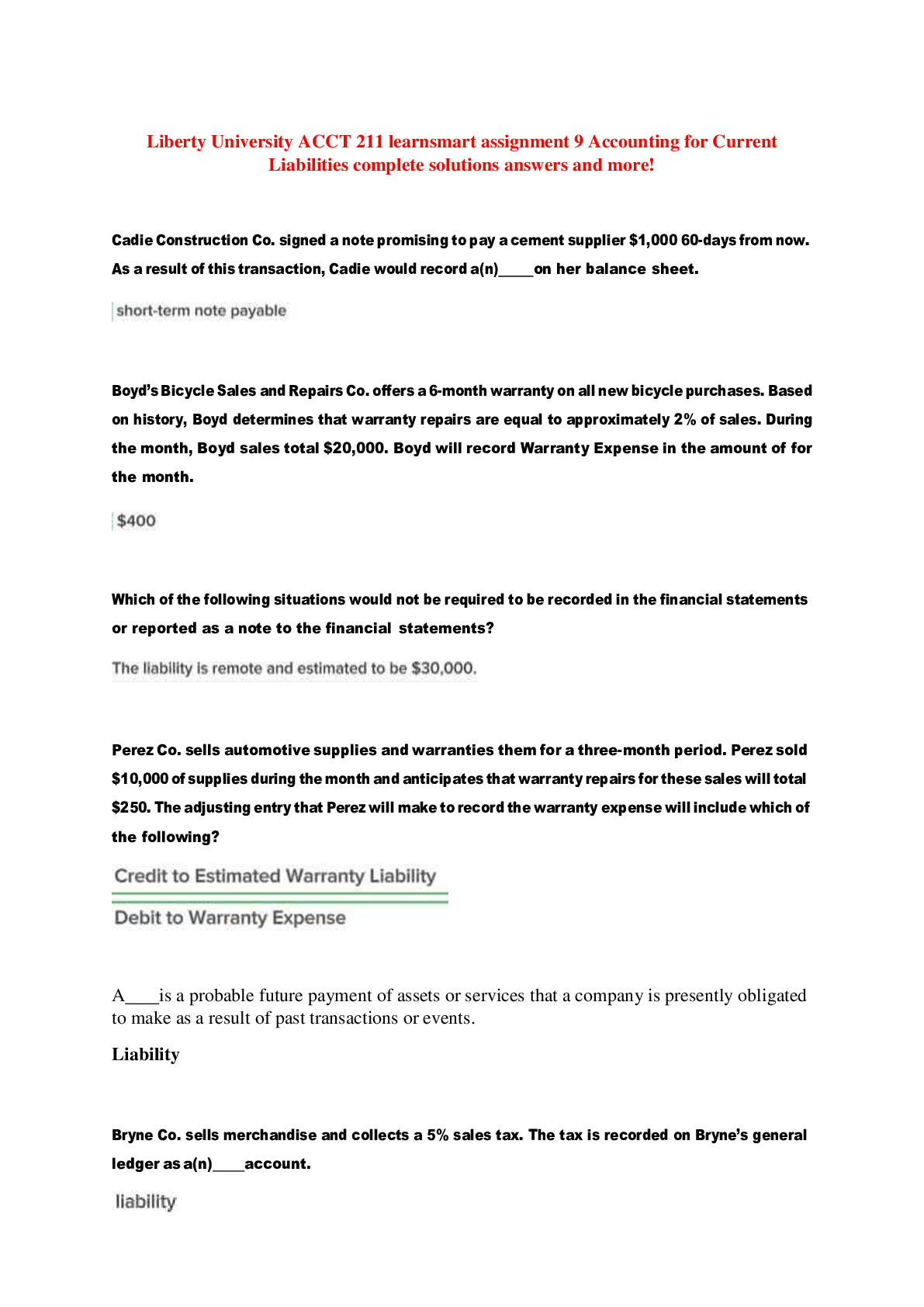Anatomy and Physiology - A&P 1 > QUESTIONS & ANSWERS > Cumulative Midterm Exam (Biology) (All)
Cumulative Midterm Exam (Biology)
Document Content and Description Below
BIO201_MH_V3 Topic 8: Joints Started on Thursday, September 9, 2021, 7:03 AM State Finished Completed on Thursday, September 9, 2021, 7:55 AM Time taken 52 mins 4 secs Grade 133.00 out o... f 140.00 (95%) Question 1 Correct 3.50 points out of 3.50 Flag question Question text Which subdivision of anatomy involves the study of organs that function together? Select one: a. regional b. developmental c. systemic d. histology e. surface anatomy Question 2 Correct 3.50 points out of 3.50 Flag question Question text The study of the structural features and functions of the cell is Select one: a. cytology. b. histology. c. molecular biology. d. microbiology. e. surface anatomy. Question 3 Correct 3.50 points out of 3.50 Flag question Question text The lumbar region is the Select one: a. area in front of the elbow. b. chest area. c. lower back. d. bottom of foot. e. forearm. Question 4 Correct 3.50 points out of 3.50 Flag question Question text The antebrachial region is the Select one: a. area in front of the elbow. b. chest area. c. lower back. d. bottom of foot. e. forearm. Question 5 Incorrect 0.00 points out of 3.50 Flag question Question text Posterior means Select one: a. toward the middle or midline of the body. b. away from the surface. c. closer to the head. d. closer than another structure to the point of attachment to the trunk. e. toward the back of the body. CORRECT Question 6 Correct 3.50 points out of 3.50 Flag question Question text Intermolecular forces are weak electrostatic attractions that exist between Select one: a. two molecules b. a proton and an electron c. two protons Question 7 Incorrect 0.00 points out of 3.50 Flag question Question text A substance composed of two or more different types of atoms is a(n) Select one: a. compound. b. element. c. ion. d. molecule. e. compound and a molecule. CORRECT Question 8 Correct 3.50 points out of 3.50 Flag question Question text DNA Select one: a. must travel to ribosomes to function. b. contains the sugar deoxyribose. c. is a single-stranded molecule. d. is one of several amino acids. e. assembles amino acids to make proteins.. Question 9 Correct 3.50 points out of 3.50 Flag question Question text Eicosanoids Select one: a. are structural proteins. b. are fat-soluble vitamins. c. are components of the plasma membrane. d. comprise the genetic material. e. play a role in the response of tissues to injuries. Question 10 Correct 3.50 points out of 3.50 Flag question Question text Phospholipids Select one: a. contain subunits called amino acids. b. are water-soluble. c. are a type of steroid. d. are fat-soluble vitamins. e. are found in cell membranes. Question 11 Correct 3.50 points out of 3.50 Flag question Question text Which of the following could be used to study general features of cells? Select one: a. a magnifying glass b. scanning electron microscope c. transmission electron microscope d. binoculars e. light microscope Question 12 Correct 3.50 points out of 3.50 Flag question Question text Glycolipids would contain both lipids and Select one: a. carbohydrates. b. proteins. c. electrolytes. d. cholesterol. e. amino acids. Question 13 Correct 3.50 points out of 3.50 Flag question Question text Cytoplasm is found Select one: a. in the nucleus. b. outside the nucleus but inside the plasma membrane. c. in the cisternae of the endoplasmic reticulum. d. on the cristae of the mitochondria. e. between the phospholipids in the plasma membrane. Question 14 Correct 3.50 points out of 3.50 Flag question Question text The structural RNA of ribosomes is a Select one: a. pre-mRNA. b. proenzyme. c. gene. d. ribosomal RNA (rRNA). e. codon. Question 15 Correct 3.50 points out of 3.50 Flag question Question text Chromosomes begin migrating towards poles of the cell during Select one: a. interphase. b. prophase. c. metaphase. d. anaphase. e. telophase. Question 16 Correct 3.50 points out of 3.50 Flag question Question text What type of epithelial tissue is found in the mouth? Select one: a. simple cuboidal epithelium b. simple columnar epithelium c. stratified squamous epithelium d. pseudostratified ciliated columnar epithelium e. transitional epithelium Question 17 Correct 3.50 points out of 3.50 Flag question Question text Which of the following statements concerning the process of tissue repair is false? Select one: a. In regeneration, destroyed cells are replaced by the same type of cells. b. In replacement, a new type of tissue develops that eventually results in scar production. c. Labile cells cannot be replaced by the process of regeneration. d. Stable cells do not actively replicate after growth but retain the ability to regenerate. e. Permanent cells have a limited ability to replicate. Question 18 Correct 3.50 points out of 3.50 Flag question Question text A tissue has the following characteristics: free surface, single layer of cells, cells are narrow and tall, microvilli, many mitochondria, goblet cells. Which of the following is most consistent with those observations? (1) active transport (2) epithelium (3) simple epithelium (4) columnar epithelium (5) cuboidal epithelium (6) squamous epithelium (7) secretion by exocytosis (8) movement of mucous across its surface Select one: a. 1, 2, 3, 4, 7 b. 1, 2, 3, 5, 7 c. 1, 2, 3, 4, 8 d. 2, 3, 4, 8 e. 2, 3, 4, 7 Question 19 Correct 3.50 points out of 3.50 Flag question Question text Which of the following pairs is mismatched? Select one: a. endoderm - bone b. mesoderm - muscle c. ectoderm - skin d. neuroectoderm - nervous system e. neural crest cells - peripheral nervous system, skin pigment, tissues of the face Question 20 Correct 3.50 points out of 3.50 Flag question Question text The epidermal layer that is present in the nail bed and the nail matrix is the Select one: a. stratum corneum. b. stratum lucidum. c. stratum basale. d. stratum spinosum. e. stratum lunula. Question 21 Correct 3.50 points out of 3.50 Flag question Question text The diagram illustrates glands of the skin. What does "C" represent? Select one: a. apocrine sweat gland b. sebaceous gland c. eccrine sweat gland d. duct of eccrine sweat gland e. sweat pore f. hair follicle [Show More]
Last updated: 1 year ago
Preview 1 out of 21 pages
Instant download

Buy this document to get the full access instantly
Instant Download Access after purchase
Add to cartInstant download
Reviews( 0 )
Document information
Connected school, study & course
About the document
Uploaded On
Dec 03, 2022
Number of pages
21
Written in
Additional information
This document has been written for:
Uploaded
Dec 03, 2022
Downloads
0
Views
96

